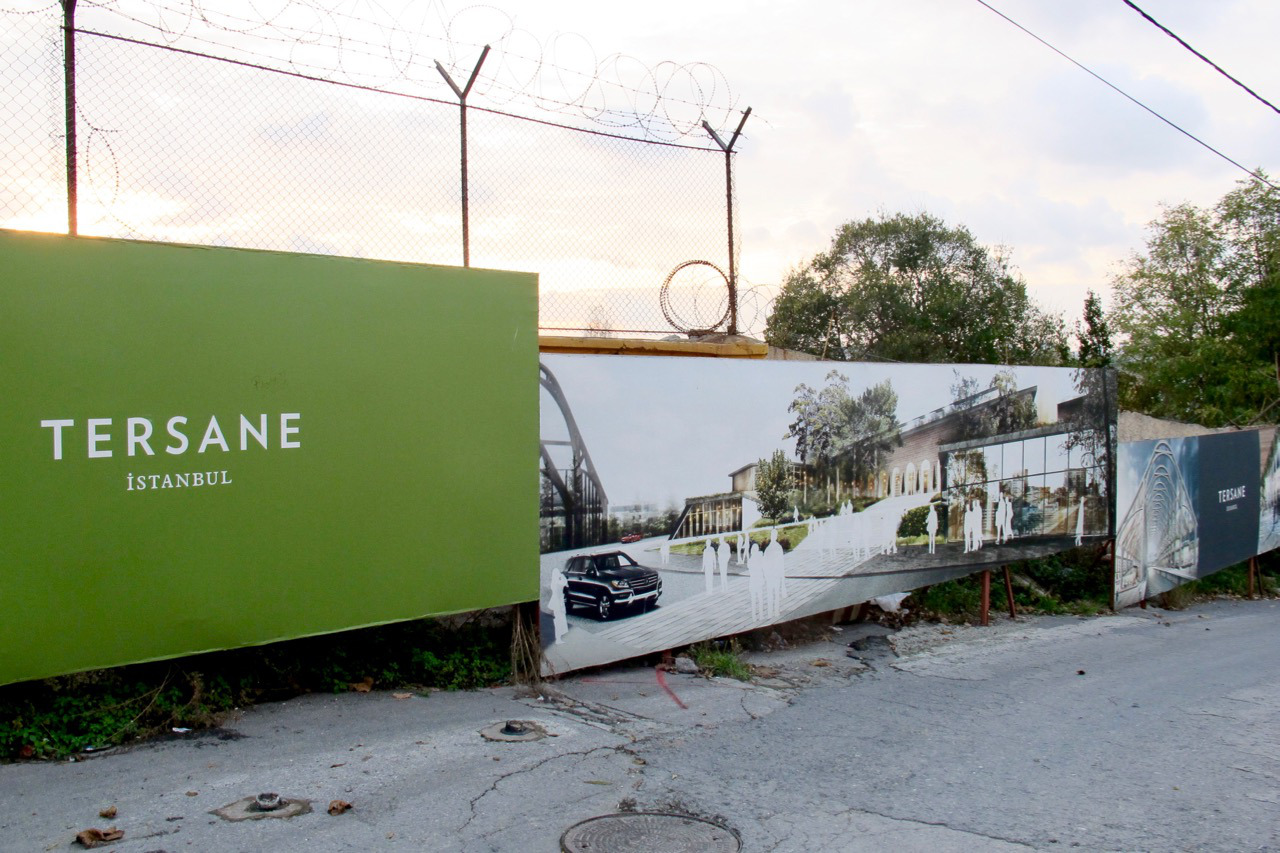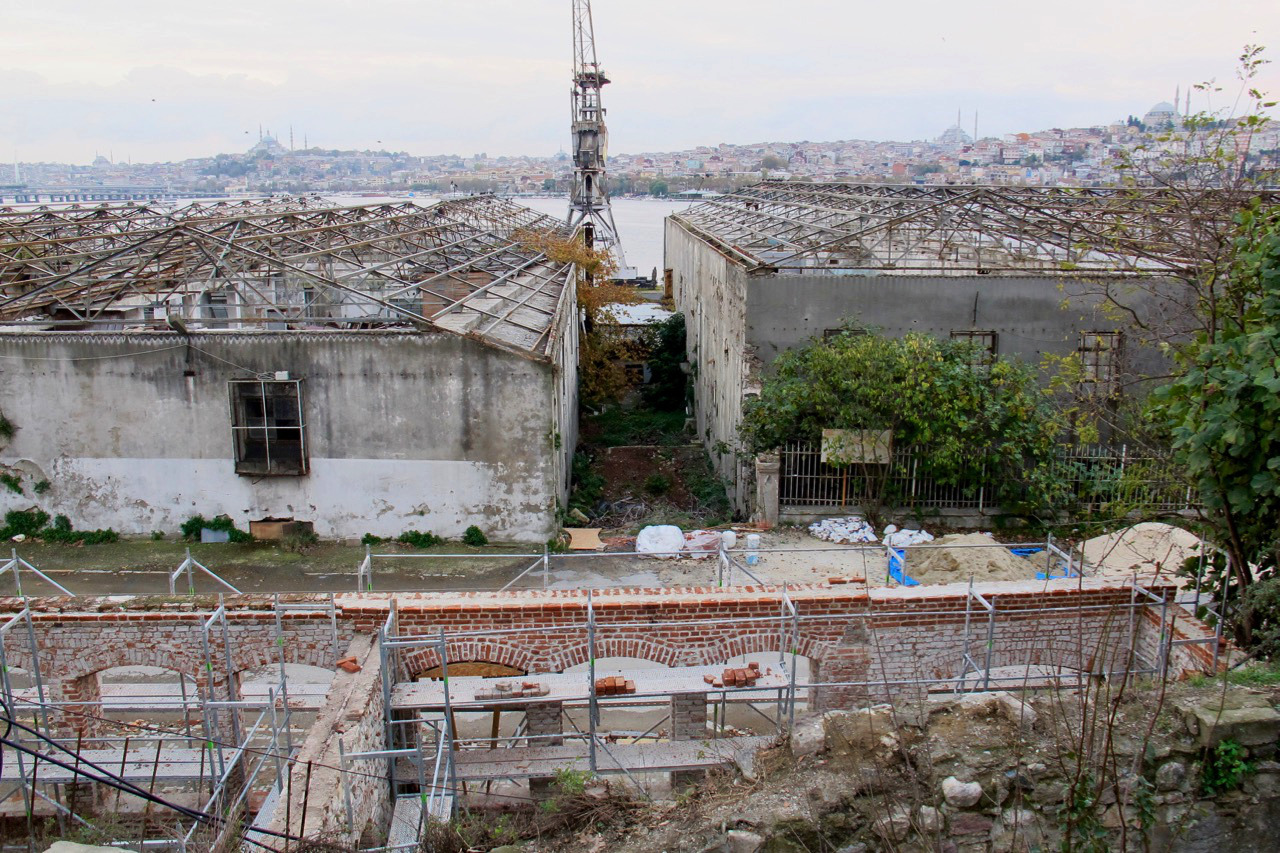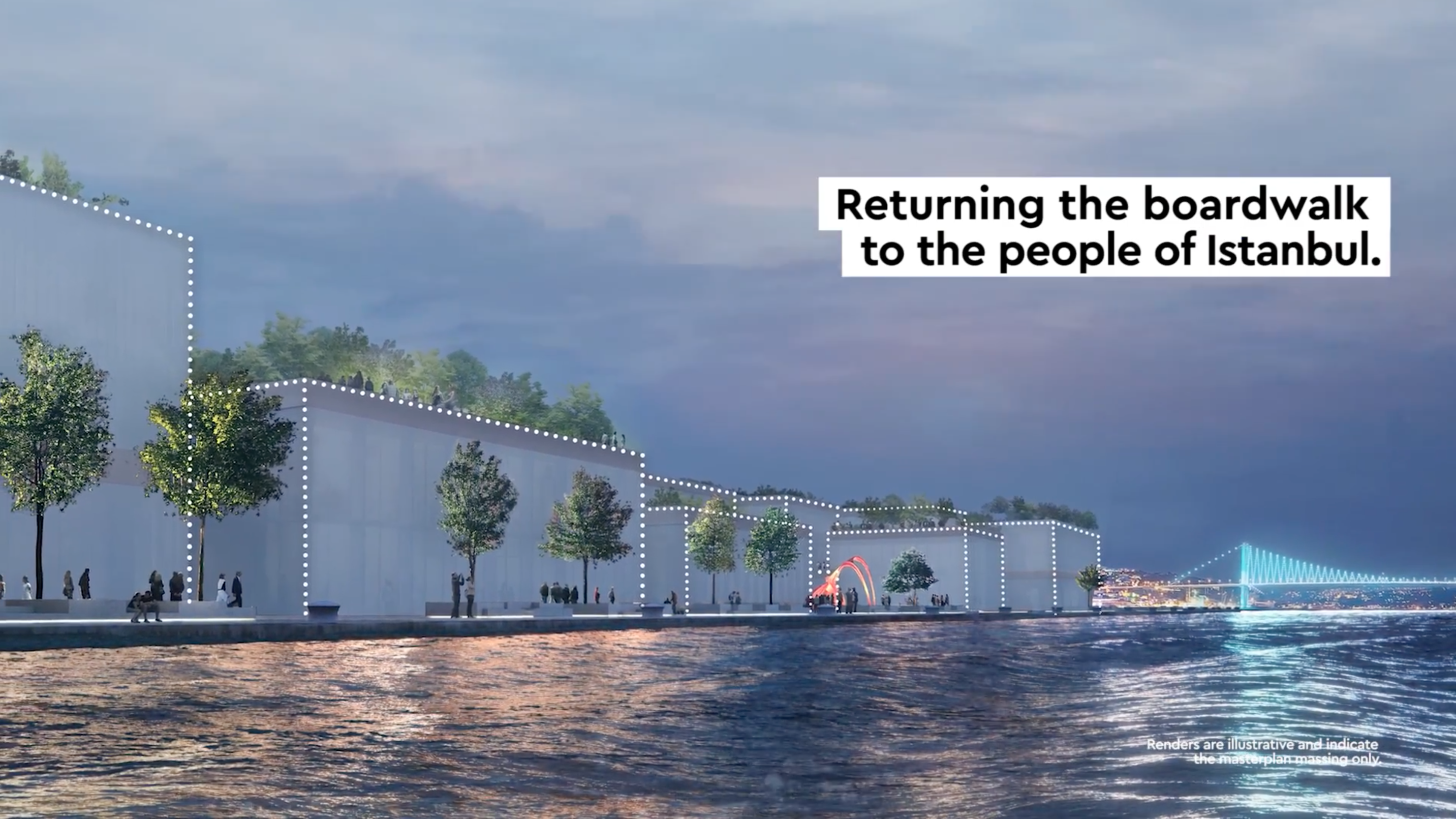The Dash column explores art and its social contexts. The dash separates and the dash joins, it pauses and it moves along. The dash is where the viewer comes to terms with what they’ve seen. Here, Berin Golonu sifts through the accidental environmentalism of the 2019 Istanbul Biennial.

Tersane Istanbul construction site. Photo by the author.
Curator Nicolas Bourriaud titled the 16th Istanbul Biennial The Seventh Continent after the mass of plastic garbage floating in the Pacific Ocean, larger than France, Italy, and Spain combined. Given the multitude of environmental concerns affecting rapidly growing cities like Istanbul, I went looking for works that addressed some of these Anthropocene realities with a sense of urgency. Yet Bourriaud’s exhibition appeared largely apolitical. Rather than prompting a needed conversation about the systems that both shape our habitats and drive our ecocidal growth, the exhibition’s abstract curatorial framework situated even the few works steeped in ecological grief at a safe distance from the sociopolitical facts behind them. By using abstruse phrases such as “molecular anthropology” to describe how artists are exploring the interactions of the human-made and the natural, Bourriaud seemed to consider ecology simply as a watershed of new ideas to be exploited.
Ironically, a last-minute change in the biennial’s plans shed light on the contradictions of its political and economic conditions, and addressed its theme more incisively than any one work or project on display. The main venue was originally located in the historic shipyards of Haliç (the Golden Horn). Yet the discovery of asbestos at the site was publicly announced a month before the biennial’s scheduled opening. (Two other venues were not affected: the Pera Museum, which has been used as a Biennial venue in the past, and six sites on the largest Prince’s Island on the Marmara Sea, mostly in and around the island’s nineteenth century structures.) During the opening press conference, Bourriaud himself stated that the danger lurking in the Haliç building “unintentionally” pointed to ecological concerns. Given the history of real-estate development in Istanbul, however, these issues might have been foreseen.
A majority of the works were ultimately exhibited in the new building of the Mimar Sinan Fine Arts University’s (MSGSÜ) Istanbul Museum of Painting and Sculpture, situated within the massive Galataport urban transformation project. Biennial visitors taking a break on the fourth-floor balcony of the MSGSÜ were treated to a behind-the-scenes look at Galataport’s construction zone, covering a kilometer of the Bosporus shoreline from the Fındıklı to the Karaköy districts, as the machinations of Istanbul’s neoliberal transformation unfolded in real time. Meanwhile, in Haliç, plans moved ahead for the billion-dollar-plus Tersane Istanbul (previously known as the Haliçport project) that will transform a large portion of Istanbul’s historic shipyards into a high-end tourism zone including yacht harbors, five-star hotels, shopping centers, conference centers, museums, restaurants, and a place of prayer.

Tersane Istanbul construction site. Photo by the author.
Cultural institutions have played a key role in the privatization of Istanbul’s waterfront. Developers tout museums—including those already sited in neighborhoods earmarked for transformation—as one of many benefits of urban renewal. During the groundbreaking of Tersane Istanbul in early 2019, President Recep Tayyip Erdoğan was sure to point out that the project would feature three new museum buildings, including Istanbul’s first museum of women and the Koç-owned Sadberk Hanım Museum. This seemed to preempt protest against the privatization of Istanbul’s cultural heritage: the shipyards contain structures that date from the Ottoman conquest and settlement of the city in the fifteenth century
The Eczacıbaşı conglomerate launched The Istanbul Foundation for Culture and Arts (IKSV), which runs the Biennial, in 1987. Koç Holding has been the foundation’s main sponsor since 2007. Koç’s plans to move one of their museums to Tersane explains the IKSV’s interest in repurposing the shipyards as a site of cultural production. The IKSV is also the commissioner for Turkey’s pavilion at the Venice Biennale, situated inside the Arsenale shipyard complex that was once the seat of Venice’s naval industry. For the Venice Architecture Biennial’s 2016 edition, the IKSV’s committee selected a project by Teğet Mimarlık titled Darzanà, a model of a large ship built entirely from materials found in the shipyards of Haliç. While Darzanà ostensibly highlighted the networks of trade and empire between the waterways of Istanbul and Venice, its ulterior purpose of legitimizing Tersane Istanbul by boosting the Haliç shipyards was duly noted. The similarities between the two shipyards end when you compare the historical fidelity of the modern-day Arsenale to the glitzy shopping, hotel, and museum complex envisioned for the dusty ruins of Haliç.

Still from a promotional video for Galataport. Dror+Gensler, 2017.
While cities across the world compete for tourists through urban transformation projects and new museums, Istanbul’s remodeling has been unusually rapid. Development plans come together behind closed doors, with no transparency or accountability, and without the involvement of civic and community groups. Moreover, the literal fallout of rushed demolition poses a significant danger to public health, especially to the construction workers on the ground. Academic and labor activist Aslı Odman, who has produced maps of likely asbestos contamination in Istanbul, refers to the construction industry’s disregard for proper disposal and remediation as a “construction crime.” She states in an alarming article that, in the next fifteen years, 7.5 million buildings across the country are slated to be seismically retrofitted, restored, and reconstructed. Most of these buildings contain deposits of asbestos, but it’s in the best interests of the construction and development sector to understate this risk. Rather than enforcing rules and regulations to limit asbestos exposure, Turkey’s ruling party has been passing laws that allow the construction industry to work even faster.

Tersane Istanbul construction site. Photo by the author.
The Istanbul Biennial has contributed tremendously to the growth of the local arts industry over the past thirty-two years. Likewise, it is embroiled in urban renewal projects that result in displacement, gentrification, and the erasure of collective memory. Local artists and activists are well aware of this paradox, and have spoken out against the Biennial’s complicity in years past. In a memorable example, a group of activists calling themselves the Platform for Public Resistance disrupted a performance organized by IKSV in the months before the opening of the 13th Istanbul Biennial. This action coincided with the Gezi Park protests in May and June 2013, and shared some common demands. The activists circulated a letter that outlined how the Biennial’s use of empty or underused spaces (some in transitional neighborhoods) was the first step in the gentrification of those spaces, and over one hundred artists, critics, and curators signed a statement in their support. The 13th Biennial’s curator Fulya Erdemci responded by withdrawing the projects that had been earmarked for public spaces so as not to “legitimize Istanbul’s rampant transformation,” while Andrea Phillips, co-organizer of the performance upstaged by the protestors, called for “work that might create real long-term change for local people.”
Local people are already fighting for change—or rather, against it. Architect Gül Köksal is part of the Haliç Resistance Platform, a varied group of individuals including people researching the heritage of the shipyards, former shipyard workers, and residents of the surrounding neighborhoods that has been fighting Tersane Istanbul from the beginning. Köksal approached the Istanbul Biennial on the Platform’s behalf and explained the certain danger of asbestos posed by demolitions in the shipyards. She explains that the company developing the shipyards, the Fettah Tamince-owned Rixos Hotel Group, downplayed the risk of asbestos and did not allow neutral, third party investigators onto the site to conduct tests. Bige Örer, current director of the Istanbul Biennial, confirmed over email that asbestos reports on the section of the shipyards earmarked for the exhibition had initially come out clean, but contamination was revealed upon the biennial’s request for additional tests in the surrounding shipyard complex.
Now that its toxic ecology has been exposed, what will happen to Tersane Istanbul? Köksal believes not much will change. There is too much investment in the project, too much support from Turkey’s political leadership, and more importantly, too much money to be made. The biennial’s visitors may have narrowly escaped exposure at close range. As demolition and construction continue, however, workers and the residents of the mostly low-income neighborhoods abutting the shipyards will continue to breathe contaminated air. Meanwhile, civic groups and political opponents continue to fight. They have taken to the courts to demand greater transparency, inclusion of civic and community groups, and for the preservation of historical and cultural heritage. These cases are the reason that the Haliçport project changed its name to Tersane Istanbul and unveiled a revised plan. It remains to be seen if the new plan is different in more than name.

Still from an advertisement for the 2019 Istanbul Biennial.
In this harsh light, it is significant that Bourriaud’s ecology-themed biennial conveniently avoided a critique of the specific socio-political and economic structures impacting urban ecologies across the world. Even the biennial’s satirical advertisements seemed to divert the blame from corporate or political entities to suggest that our personal actions or consumer choices, not corporate greed, are responsible for our environmental crises. In these ads, The Seventh Continent’s diplomat—a giant trash bag—thanks the public for expanding its territory by consuming ever more plastic. This focus on the symptom over the cause—demonizing the use of plastic rather than the growth of the petrochemical industry, for example—served to exculpate those profiting from the neoliberal global order.
In one exception, and upon Bourriaud’s direct invitation, a group of young artists and curators named birbuçuk organized a series of public events on topics such as “water,” “concrete,” and “petroleum.” Some of their invited speakers voiced their support of a letter circulated by activists who took the Biennial’s sponsors to task for their involvement in the fossil fuel industry. Odman, who was also one of the speakers, talked about asbestos contamination in Turkey, pointing out the complicity of companies owned by the biennial’s sponsors. Yet the dialogues initiated by the birbuçuk collective were restricted to a small audience and never grew into a voluble call for change. Indeed, each iteration of the Biennial in the last decade has met with disparate protests, but no sustained movement. Appointing a different curator for every exhibition and working with curators from abroad severs the possibility of continuing such a dialogue over the years. In a similar vein, participating artists from abroad may be less aware of the socio-economic realities of a specific context of display—let alone those hidden in the walls themselves.
As for artists based Turkey, they are less likely to speak up against the Biennial’s complicity in projects like Tersane Istanbul because they are more vulnerable to the punitive measures of an increasingly authoritarian political regime. The trial and indictment of arts patron Osman Kavala, charged with absurd and unsubstantiated crimes such as initiating and inciting the Gezi protests, set a brutal example for anyone who dares to program work with overt political messages. Aslı Çetinkaya, who is a project coordinator at the Istanbul-based non-profit DEPO, told me that even guest curators coming from abroad are now worried about showcasing work or addressing topics that might be deemed too controversial in Turkey. Artists in Turkey are also dealing with very different socioeconomic realities than artists in the US or Europe who have recourse to a wider funding base and who feel free to agitate against patrons such as the Sackler family, Warren B. Kanders, and British Petroleum. The arts in Istanbul are funded almost entirely by two families: the Eczacıbaşı family, and the Koç family, both of whom sponsor the IKSV, and who are also the biggest collectors of art in Turkey. Until a more robust funding ecology can develop, local artists will work in a climate of self-censorship.
The truth, however, is that our climate crisis can’t wait. I wish to end where I began—with the urgency of honest discussion about how the structural forces shaping our growth, our habitats, and our ecocide are closely intertwined. I doubt anyone was fooled by the disingenuousness of a biennial that paid lip service to pressing ecological concerns without making a sincere commitment to facing them. Clearly, corporate entities’ drive to expand clashes with the need to put the health of our planet first. If artists could only recognize the power they hold over arts organizations, which could not survive without them, they could throw off the cloak of silence and speak openly about these pernicious conflicts of interest. As for the IKSV, if it is compromised by the investments and business interests of its sponsors, it should have chosen another theme rather than trying to exploit the Anthropocene as the art world’s latest trend. x

Berin Golonu is an Assistant Professor of Art History and Visual Culture at SUNY Buffalo. She has been attending and writing about the Istanbul Biennial since 2003.